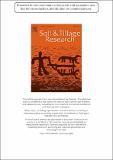| dc.contributor.author | Ngome, Ajebesone | |
| dc.contributor.author | Becker, Mathias | |
| dc.contributor.author | Mtei, Kelvin | |
| dc.contributor.author | Mussgnug, Frank | |
| dc.date.accessioned | 2023-09-12T09:10:28Z | |
| dc.date.available | 2023-09-12T09:10:28Z | |
| dc.date.issued | 2011-12-01 | |
| dc.identifier.uri | https://doi.org/10.1016/j.still.2011.08.010 | |
| dc.identifier.uri | https://dspace.nm-aist.ac.tz/handle/20.500.12479/1977 | |
| dc.description | This research article was published by Elsevier in 2011 | en_US |
| dc.description.abstract | Soil fertility loss in Western Kenya is exacerbated by inadequate nutrient management and causes reduced maize yields. Given the diversity of soil types, cropping seasons, and the resource endowment of farmers, the magnitude of the soil fertility decline and the effectiveness of management options to counteract this decline is likely to differ. Five organic and inorganic management options were compared with farmers’ practice regarding their effects on soil fertility attributes and nutrient balances/use efficiencies in maize on three contrasting soils of Western Kenya and over two cropping seasons. Irrespective of the season, organic amendments were more effective than mineral fertilizers in enhancing soil carbon stocks and the labile and non-labile C fractions. The largest soil C content (4.1%) and C pool (72 Mg ha−1) were observed on the clay Nitisol after two seasons of reduced tillage, while the lowest C content (1.1%) and C pool (22 Mg ha−1) were observed on the sandy Acrisol with conventional tillage. Total soil N content was consistently higher with mineral than with organic fertilizer use and more so on Nitisol than on Ferralsol or Acrisol. The soil N supplying capacity increased with the application of both organic and mineral fertilizers and reached 210 mg kg−1 after two weeks of anaerobic incubation of the mineral N-amended Acrisol. Bray-I P content reflected the P application rates and was highest (50–66 mg kg−1) on the Acrisol with mineral P fertilizer use and lowest (1.5 mg kg−1) on the Ferralsol in the unamended control treatment. Partial N and P balances were generally positive except for the mineral N-amended treatments on the Nitisol. The efficiency of applied N varied from 29 to 135 kg kg−1 N with lowest values in the sandy Acrisol under reduced tillage. These differential responses to management options in different soil types were reflected in maize grain yields with highest cumulative yields of 4.7–9.4 Mg ha−1 a−1 in the Nitisol and 1.4–7.4 Mg ha−1 a−1 in the Acrisol and the Ferralsol. We may conclude that the tested technology options differentially affected soil fertility and production attributes. The extent of this response depended on the cropping season and the soil type, supporting the need for site-specific nutrient management and technology targeting. | en_US |
| dc.language.iso | en | en_US |
| dc.publisher | Elsevier | en_US |
| dc.subject | Research Subject Categories::NATURAL SCIENCES | en_US |
| dc.title | Fertility management for maize cultivation in some soils of Western Kenya | en_US |
| dc.type | Article | en_US |

